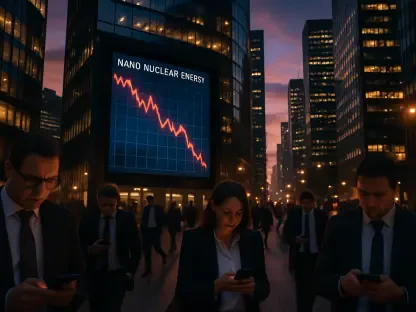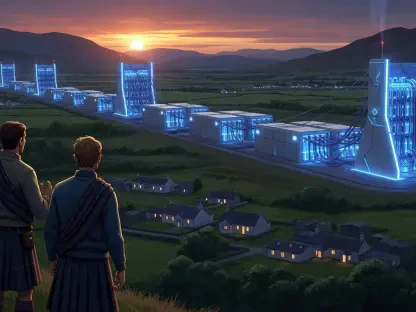Santa Cruz County, California, has stepped into the spotlight with the release of a draft ordinance aimed at regulating Battery Energy Storage Systems (BESS), a critical component in the push for renewable energy. These systems, designed to store power from sources like solar and wind, play a pivotal role in stabilizing the electrical grid and reducing greenhouse gas emissions. Yet, their potential risks have come under intense scrutiny following high-profile safety incidents in nearby regions. The newly proposed Energy Storage Combining District Ordinance seeks to establish a framework for safe and sustainable BESS development in unincorporated areas of the county. By addressing where these facilities can be located, how they must operate, and what safety standards are mandatory, the county is striving to harmonize the benefits of clean energy with the pressing need to protect local communities and the environment from potential hazards.
This initiative arrives at a moment when the balance between innovation and caution is more crucial than ever. With a specific BESS project near Watsonville drawing attention and public concern heightened by past disasters, Santa Cruz County faces a complex challenge. The ordinance is not just a set of rules but a reflection of broader tensions in the renewable energy sector. It aims to ensure that progress does not come at the expense of safety, setting a precedent for how local governments can navigate these issues. This article explores the intricacies of the draft ordinance, the timeline for its adoption, the controversial Minto Road project, community reactions, and the critical lessons learned from past incidents that have shaped this regulatory effort.
Crafting a Safe Framework for BESS
The Energy Storage Combining District Ordinance represents a comprehensive attempt by Santa Cruz County to regulate the burgeoning field of Battery Energy Storage Systems. It meticulously outlines criteria for suitable locations, ensuring that only specific sites meeting stringent conditions can host such facilities. Safety and environmental standards are at the forefront, with detailed requirements to mitigate risks and protect surrounding areas. The ordinance also establishes a structured process for applications, incorporating rigorous oversight to monitor compliance. A key feature is the inclusion of public review periods, allowing community input to shape final decisions, while provisions for updating safety protocols based on emerging research ensure the rules remain relevant. This approach is designed to prevent the adoption of outdated or risky technologies, prioritizing long-term security over short-term gains in the county’s push toward renewable energy integration.
Beyond the technical specifics, the draft ordinance underscores a proactive stance by county officials to address potential hazards before they manifest. By defining clear boundaries—such as setbacks from sensitive areas like schools and residential zones—the regulations aim to minimize impacts on neighborhoods and natural resources. The emphasis on continuous monitoring and collaboration with local fire districts further reflects a commitment to adaptability in the face of evolving technology. Importantly, the ordinance seeks to learn from past mistakes in other regions, ensuring that BESS facilities in Santa Cruz County adhere to the highest possible standards. This careful planning is not merely about restriction but about fostering trust among stakeholders that renewable energy infrastructure can coexist with community well-being, setting a model for how local policies can support global climate goals without compromising safety.
Navigating the Road to Adoption
The path to implementing the draft ordinance is marked by a deliberate and extended timeline, reflecting the county’s commitment to thoroughness. Scheduled for presentation to the Santa Cruz County Board of Supervisors on November 18, the proposal will undergo public hearings in the summer of 2026, with final adoption anticipated in the fall of that year. This process includes the completion of a supplemental Environmental Impact Report (EIR), a crucial step to assess potential ecological consequences before any BESS project can proceed to public approval. Such a timeline, while ensuring comprehensive evaluation, has sparked concerns among developers who face mounting costs due to delays. The prolonged schedule means that no project can advance until late 2026 at the earliest, creating a bottleneck for initiatives critical to meeting renewable energy targets and testing the patience of industry players eager to move forward.
This extended timeline also highlights a broader challenge in balancing regulatory diligence with the urgency of energy infrastructure development. Developers argue that delays could jeopardize their projects’ viability, particularly as they navigate financial pressures to maintain their position in the state grid queue. Meanwhile, the county’s insistence on a detailed review process signals a prioritization of community safety and environmental protection over expediency. The inclusion of public hearings in 2026 offers a platform for residents to voice concerns, potentially shaping the final ordinance to better reflect local needs. However, this drawn-out approach risks creating friction with state-level policies that could override local decisions if delays persist too long. Santa Cruz County must tread carefully to ensure that its meticulous planning does not inadvertently stall progress on sustainable energy solutions.
Examining the Minto Road Proposal
At the heart of the BESS debate in Santa Cruz County lies a proposed 200-megawatt facility on 14 acres near Minto Road, adjacent to a PG&E substation outside Watsonville. Spearheaded by New Leaf Energy, this project encompasses around 300 containers, each equipped with individual fire-suppression systems to mitigate risks. Additional safeguards, such as a rubber bladder to prevent liquid leakage into nearby College Lake, have been integrated to address environmental concerns. Proponents highlight the facility’s potential to enhance grid reliability, a critical factor in managing fluctuating renewable energy supplies. Beyond technical benefits, the project promises economic advantages, including revenue for local schools, positioning it as a contributor to both climate goals and community welfare, provided it secures the necessary permits and public approval under the new ordinance.
Despite its potential upsides, the Minto Road project faces significant hurdles tied to the broader regulatory and social context. Its progression is contingent on the adoption of the county’s ordinance, meaning it remains in limbo until late 2026 at the earliest, pending the completion of environmental reviews and public hearings. This delay adds financial strain to developers, who must sustain their investment while awaiting clarity on local rules. Meanwhile, the project serves as a litmus test for how well the draft ordinance can balance innovation with precaution. Supporters argue that its design incorporates modern safety features far superior to older facilities, yet its location near residential and ecological areas continues to fuel apprehension among locals. As a flagship case, the Minto Road proposal encapsulates the county’s challenge of aligning renewable energy ambitions with the imperative to safeguard its communities from unforeseen risks.
Learning from Past Disasters
The urgency behind Santa Cruz County’s draft ordinance is deeply rooted in a sobering incident that unfolded on January 16 at the Vistra BESS plant in Moss Landing, Monterey County. A fire involving hundreds of lithium batteries in an outdated warehouse resulted in evacuations and a hazardous smoke plume that reached as far as Santa Cruz County. This disaster exposed the vulnerabilities of BESS when not paired with modern safety designs, prompting widespread alarm about the potential for similar events closer to home. Although environmental testing post-incident indicated that levels of heavy metals in soil and water were largely within safe limits as per EPA standards, the event left an indelible mark on public perception, amplifying calls for stringent regulations to govern such facilities and prevent catastrophic outcomes in the future.
The Moss Landing fire has become a cautionary tale driving the county’s regulatory approach, emphasizing the need for updated infrastructure and robust safety protocols. It spurred nearby jurisdictions to impose temporary moratoriums on new BESS projects, reflecting a regional shift toward caution. In Santa Cruz County, the incident has directly influenced the draft ordinance’s focus on excluding certain battery chemistries deemed riskier and mandating continuous monitoring systems. The memory of toxic smoke and community displacement serves as a stark reminder of what’s at stake if safety is sidelined. This historical lesson underscores why the county is prioritizing rigorous standards over rapid deployment, ensuring that any new BESS facility, such as the one proposed for Minto Road, is equipped to handle emergencies without endangering lives or the environment, thus rebuilding trust in renewable energy technologies.
Addressing Community Apprehensions
The Minto Road BESS project has become a focal point of contention for Watsonville residents and local officials, who harbor significant reservations about its implications. Opposition is visibly strong, with protest signs scattered across the area signaling widespread unease about hosting such a facility near homes and sensitive ecological zones. The Watsonville City Council, under the leadership of Council Member Ari Parker, has taken a formal stance by submitting a letter to the county, urging a voice in the approval process. Concerns center on the potential for a disaster akin to Moss Landing, which could threaten air quality, agricultural land, and residential safety. This community pushback reflects a deeper anxiety about whether the benefits of renewable energy infrastructure justify the perceived risks, especially without ironclad assurances of protection.
In response to these fears, local leaders are advocating for enhanced safeguards within the draft ordinance to address specific community needs. Council Member Parker has proposed measures like sustained funding for local fire and HAZMAT services, potentially including a dedicated fire department substation to handle emergencies swiftly. Such demands highlight a broader call for accountability from BESS operators, ensuring they bear the cost of mitigating risks rather than burdening taxpayers. The opposition in Watsonville is not merely resistance to change but a plea for comprehensive planning that prioritizes long-term safety over short-term gains. As the county prepares for public hearings in 2026, these voices will likely play a crucial role in shaping the final ordinance, pushing for provisions that guarantee robust emergency preparedness and minimize any adverse impacts on the local environment and populace.
Balancing Innovation with Community Safety
Santa Cruz County’s draft ordinance encapsulates the intricate dance between advancing renewable energy infrastructure and safeguarding community well-being. It imposes stringent site restrictions, mandating that BESS facilities occupy at least 10 acres, be located outside the coastal zone, and sit adjacent to existing electrical substations. Additional setbacks of 1,000 feet from sensitive areas like schools and care facilities further limit viable locations, with Minto Road emerging as one of the few qualifying sites. These strict criteria aim to reduce potential hazards while accommodating the technical needs of energy storage systems. However, they also underscore the limited options for development, intensifying the focus on ensuring that approved projects meet the highest safety and environmental standards without stifling progress toward sustainable energy goals.
This careful regulatory approach is set against a backdrop of competing interests, where developers, residents, and policymakers must find common ground. The frustration of industry stakeholders over the extended timeline for ordinance adoption contrasts sharply with community demands for even tougher protections, as seen in Watsonville’s activism. State legislation, such as AB 205, adds another layer of complexity by potentially allowing overrides of local rules if delays hinder broader public interests, creating uncertainty for projects like Minto Road. The county’s challenge lies in crafting a policy that addresses legitimate safety concerns while avoiding bottlenecks that could derail critical infrastructure. This balancing act is emblematic of a larger trend in the renewable energy sector, where the urgency to combat climate change must be reconciled with the imperative to protect local environments and populations from unintended consequences.
Reflecting on a Path Forward
Looking back, Santa Cruz County’s efforts to regulate Battery Energy Storage Systems through the draft ordinance marked a significant moment in addressing the dual imperatives of renewable energy and public safety. The detailed provisions tackled past failures head-on, drawing from incidents like the Moss Landing fire to enforce modern safety designs and thorough environmental reviews. Community engagement stood as a cornerstone, with public hearings planned to capture diverse perspectives before final adoption in late 2026. The Minto Road project, despite its promise, became a lightning rod for local fears, underscoring the necessity of trust-building measures.
Moving forward, the county needed to refine this framework by integrating stronger emergency funding mechanisms and ensuring developers shared responsibility for risk mitigation. Collaboration with local fire districts and ongoing safety research were vital steps to adapt to technological advancements. As Santa Cruz County navigated this complex terrain, the focus remained on crafting a model that other regions could emulate, proving that renewable energy infrastructure could thrive alongside stringent protections for community and environmental health.









